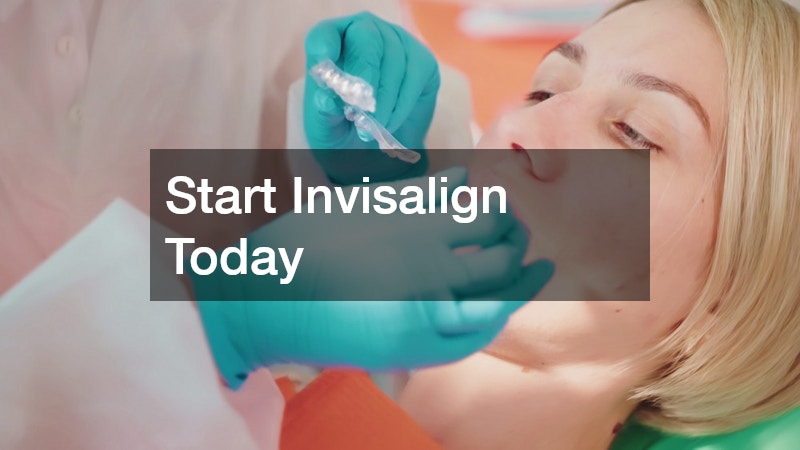
In recent years, Invisalign has transformed the field of orthodontics by offering a modern, nearly invisible way to straighten teeth. Gone are the days when metal brackets and wires were the only solution for achieving a perfect smile. Invisalign uses a series of custom-made, clear aligners to gradually shift your teeth into place—offering both comfort and discretion. This article explores how Invisalign works, what makes it different from traditional braces, and who can benefit from this innovative treatment.
What is Invisalign and How Does It Compare to Traditional Braces?
Invisalign is an orthodontic treatment that uses a series of clear, removable aligners to correct misaligned teeth and bite issues. Each set of aligners is worn for about one to two weeks before switching to the next set, slowly guiding teeth into their ideal position. Invisalign aligners are made from a patented, medical-grade thermoplastic material called SmartTrack. This BPA-free plastic is durable, comfortable, and specifically designed to apply gentle yet consistent pressure on teeth. The aligners are transparent, smooth, and custom-fitted to each patient’s mouth for a precise, comfortable fit.
Treatment Process Overview
The Invisalign treatment process typically follows these steps:
-
Consultation – Your dentist or orthodontist assesses your teeth and determines if Invisalign is the right option.
-
Digital Scanning – A 3D scan of your teeth is taken to create a detailed treatment plan.
-
Aligner Fabrication – Custom aligners are produced based on your treatment plan.
-
Wearing the Aligners – You’ll wear your aligners for 20–22 hours per day, removing them only for eating, drinking, and oral care.
-
Progress Checks – Regular check-ins ensure your teeth are moving as expected.
-
Retention – After completing treatment, retainers help maintain your results.
Invisalign vs. Traditional Braces
While both Invisalign and traditional braces are effective at straightening teeth, their methods and experiences differ:
-
Appearance: Invisalign aligners are nearly invisible, while braces are easily noticeable.
-
Comfort: Invisalign’s smooth plastic design avoids the irritation caused by metal wires and brackets.
-
Convenience: Aligners are removable, making it easier to eat and clean your teeth.
-
Maintenance: Braces require more frequent adjustments and can make oral hygiene more challenging.
How Are Invisalign Aligners Made and Customized?
Initial Consultation and Assessment
Your Invisalign journey begins with a consultation. The dentist or orthodontist examines your teeth, gums, and bite alignment. They’ll also discuss your goals and evaluate whether Invisalign is the most effective option for your needs.
3D Imaging and Modeling
Instead of traditional molds, Invisalign uses 3D digital imaging technology to create an exact model of your mouth. Advanced software then maps out each stage of tooth movement, showing a virtual preview of your expected results.
Fabrication of Aligners
Once your treatment plan is approved, a series of custom aligners is fabricated. Each aligner is slightly different, designed to move your teeth gradually and safely over time.
Fitting and Adjustments
When you receive your first set of aligners, your orthodontist ensures they fit correctly and comfortably. You’ll typically switch to a new set every one to two weeks as your teeth adjust.
Care and Maintenance
To keep your aligners clean and clear:
-
Rinse them with lukewarm water after removal.
-
Brush them gently with a soft toothbrush.
-
Avoid eating or drinking anything other than water while wearing them.
How Long Does Invisalign Treatment Take and What Can Affect It?
Typical Duration of Invisalign Treatment
The average Invisalign treatment takes about 12 to 18 months, depending on the complexity of your case. Some patients start seeing noticeable results in just a few weeks.
Factors Influencing Treatment Length
Treatment time varies based on several factors:
-
Severity of misalignment
-
Patient’s age
-
Type of movement required (rotations, spacing, etc.)
-
Compliance with wearing aligners
Role of Compliance
Wearing aligners 20–22 hours a day is crucial for success. Skipping wear time can delay progress and extend the overall treatment duration.
Progress Monitoring
Your orthodontist will schedule regular check-ins—usually every six to eight weeks—to monitor progress, make adjustments, and provide new aligners.
Who is a Good Candidate for Invisalign?
Ideal Dental Conditions for Invisalign
Invisalign is effective for treating:
-
Crooked or crowded teeth
-
Gaps between teeth
-
Overbites, underbites, and crossbites
Age Considerations
Invisalign works well for both teens and adults. Invisalign Teen, for example, includes special features to accommodate growing mouths and track compliance.
Limitations and Exclusions
Invisalign may not be suitable for patients with severe bite issues or those requiring significant jaw movement. In such cases, traditional braces or other orthodontic treatments may be recommended.
Consulting with Professionals
A thorough consultation with an experienced Invisalign provider ensures that you receive a personalized plan suited to your dental needs and goals.
Comparison with Other Orthodontic Solutions
For patients who don’t qualify for Invisalign, other effective treatments include clear braces, lingual braces, or orthodontic retainers.
How Effective is Invisalign for Long-term Results?
Success Rates of Invisalign
Studies show Invisalign success rates exceeding 90% for properly selected cases, making it an effective and predictable orthodontic option.
Patient Satisfaction and Feedback
Most patients report high satisfaction levels due to Invisalign’s comfort, convenience, and discreet appearance.
Post-Treatment Considerations
After completing treatment, patients typically wear retainers to maintain alignment and prevent teeth from shifting.
Addressing Relapses
If minor relapses occur, new aligners can be created to re-straighten teeth—a process known as refinement.
Long-Term Dental Health Benefits
By aligning teeth properly, Invisalign can improve bite function, make oral hygiene easier, and reduce the risk of gum disease and tooth wear.
Invisalign offers a modern, comfortable, and nearly invisible way to achieve a straighter smile without the restrictions of traditional braces. By understanding how Invisalign works—from customization to long-term care—you can make informed decisions about your orthodontic treatment. With consistent wear and guidance from a qualified dental professional, Invisalign provides lasting, beautiful results and a healthier smile you’ll be proud to show off.
